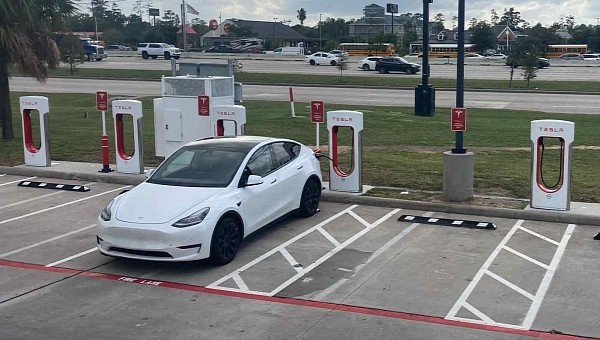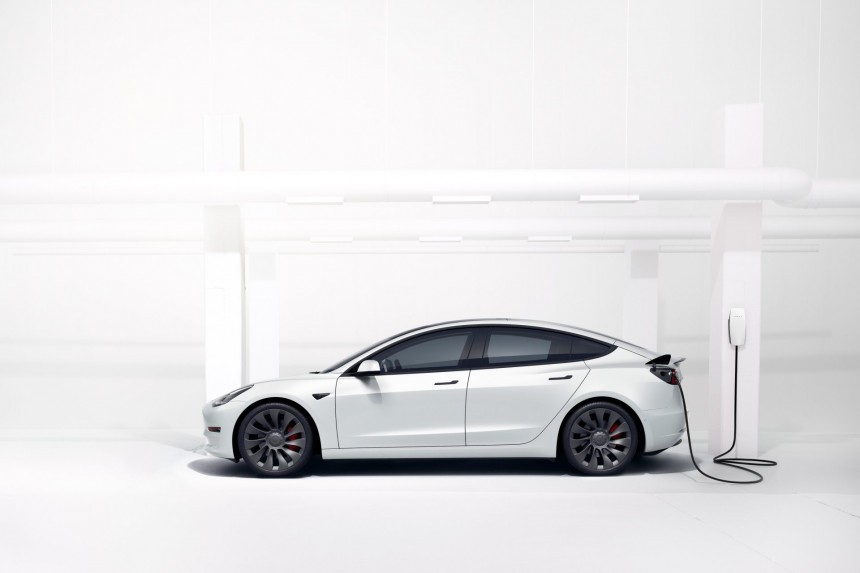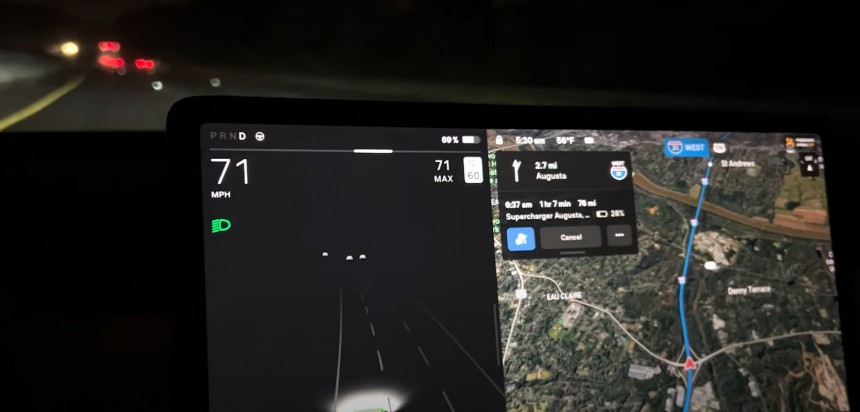A U.S. couple decided to move from Columbia, South Carolina, to Las Vegas, Nevada. This meant they had to make a 2,233-mile (3,594-kilometer) trip. It proved to be the right opportunity for a great test. Which car would cost them less for this journey? Would it be the battery-electric Tesla or the gas-powered Mazda?
Embarking on such a long journey isn’t something you would do regularly, so keep this in mind before continuing to read this story. It will help put everything better into perspective.
The couple in question decided to use both their cars for this cross-country trip – a 2020 Tesla Model 3 Long Range and a 2018 Mazda 3. Right from the get-go, the internal combustion engine vehicle (ICEV) had an advantage since it could do around 450 mi (724 km) on a full tank of gas, while the EV showed a range of 317 mi (510 km) when the battery was full.
The route planner showed that the Tesla needed four stops to reach Las Vegas, where charging would take anywhere between 20 and 40 minutes. However, things went differently for these guys. Here’s how they’ve done it.
The couple decided to turn the entire moving into another state effort into a five-day driving experience. They stopped for the first time in Memphis, Tennessee, after covering about 605 mi (974 km). To reach their destination on Day 1, the Mazda needed to refuel once, while the EV driver had to stop five times to charge the car’s battery to an appropriate level.
This was also reflected in costs, not only in time spent not driving – the charging cost was $68, while the gas cost was a little over $29.
So, how does this prove that fast-charging an EV is more expensive than filling it up? This conclusion is reached after we learn that Tesla benefitted from free Level 2 charging (240 V) on two of the five days of the trip through the destination charger network. That's why the costs differ so much when looking at the daily charging bills. On Day 1, the amount was $68, while on Day 3, the cost was only $15.9. The same thing happened on Day 5 of the trip when the Tesla needed only one stop, which cost the owner $19.3. In the other three days of traveling, fast charging always meant a cost of over $60.
If the Tesla driver had to rely only on the available Superchargers (or other fast charging, 150kW+ stalls), then the total surely would have been much higher than the Mazda’s. You can look at the total daily costs of electricity and gas in the video down below and easily figure out why I'm saying this.
On top of all this, the content creator did not account for the time needed to charge. Having the car plugged in overnight at a hotel is not much of a headache and is often free. But stopping at a Supercharger takes considerably more than just filling up with gas. It can also be quite expensive nowadays, considering the rates increased in 2022. On average, Tesla Model 3 Long Range owners spend around one hour for a full charge at a 150-kW stall.
But the charging situation is also confusing for Tesla owners that bought the company’s insurance products. The premium goes up if Tesla owners drive at night, but during these off-peak hours, the electricity prices are the lowest.
However, when you consider local road emissions, the battery-electric Tesla always comes on top. With an average Carbon Dioxide (CO2) production of 0 g/mi, because there is no exhaust at the rear of the car and no fossil fuel burning, it beats the gas-powered Mazda with ease. But when you factor in the production, the charging, and the recycling of an EV… Things might not look so good for the all-electric car. A very recent analysis showed that when a zero-tailpipe emission vehicle is not being used extensively, it can pollute the environment more than a fossil fuel-hungry car. But it also put the whole “gas good, EV bad” better into perspective.
In the end, it all boils down to user preference. For now, we have a lot of options to choose from. Be it a 1,000-HP Hummer Pickup EV or a gas-powered 122-HP Nissan Versa, U.S. drivers enjoy many great buying opportunities. All they have to do is make sure their next car suits their lifestyle, and the ownership won’t break the bank.
Because if you don't charge an EV regularly at home, there is no cost-effectiveness involved with this type of car anymore. Unless, of course, you're part of a special program like the one made by Lucid in partnership with Electrify America. But does it make sense to pay $138,000 for an Air Grand Touring to have access to two years of free fast charging? We'll let you decide.
The couple in question decided to use both their cars for this cross-country trip – a 2020 Tesla Model 3 Long Range and a 2018 Mazda 3. Right from the get-go, the internal combustion engine vehicle (ICEV) had an advantage since it could do around 450 mi (724 km) on a full tank of gas, while the EV showed a range of 317 mi (510 km) when the battery was full.
The route planner showed that the Tesla needed four stops to reach Las Vegas, where charging would take anywhere between 20 and 40 minutes. However, things went differently for these guys. Here’s how they’ve done it.
The couple decided to turn the entire moving into another state effort into a five-day driving experience. They stopped for the first time in Memphis, Tennessee, after covering about 605 mi (974 km). To reach their destination on Day 1, the Mazda needed to refuel once, while the EV driver had to stop five times to charge the car’s battery to an appropriate level.
Coasting from the East to the West
The traveling continued in a similar fashion until the couple reached their destination. In total, the Tesla needed 13 stops to recharge, which amounted to a total cost of $233.4. On the other hand, driving the Mazda 3 resulted in only nine stops to refuel which translated into spending $234.4 on gas. Using the Model 3 Long Range for this adventure saved the owner one dollar.So, how does this prove that fast-charging an EV is more expensive than filling it up? This conclusion is reached after we learn that Tesla benefitted from free Level 2 charging (240 V) on two of the five days of the trip through the destination charger network. That's why the costs differ so much when looking at the daily charging bills. On Day 1, the amount was $68, while on Day 3, the cost was only $15.9. The same thing happened on Day 5 of the trip when the Tesla needed only one stop, which cost the owner $19.3. In the other three days of traveling, fast charging always meant a cost of over $60.
If the Tesla driver had to rely only on the available Superchargers (or other fast charging, 150kW+ stalls), then the total surely would have been much higher than the Mazda’s. You can look at the total daily costs of electricity and gas in the video down below and easily figure out why I'm saying this.
On top of all this, the content creator did not account for the time needed to charge. Having the car plugged in overnight at a hotel is not much of a headache and is often free. But stopping at a Supercharger takes considerably more than just filling up with gas. It can also be quite expensive nowadays, considering the rates increased in 2022. On average, Tesla Model 3 Long Range owners spend around one hour for a full charge at a 150-kW stall.
It's not rocket science, but it's (a bit) complicated
Planning with the help of the built-in navigation system could cut the charging times or split them effectively. That's also why the content creator said he stopped multiple times on the way to Nevada.However, when you consider local road emissions, the battery-electric Tesla always comes on top. With an average Carbon Dioxide (CO2) production of 0 g/mi, because there is no exhaust at the rear of the car and no fossil fuel burning, it beats the gas-powered Mazda with ease. But when you factor in the production, the charging, and the recycling of an EV… Things might not look so good for the all-electric car. A very recent analysis showed that when a zero-tailpipe emission vehicle is not being used extensively, it can pollute the environment more than a fossil fuel-hungry car. But it also put the whole “gas good, EV bad” better into perspective.
In the end, it all boils down to user preference. For now, we have a lot of options to choose from. Be it a 1,000-HP Hummer Pickup EV or a gas-powered 122-HP Nissan Versa, U.S. drivers enjoy many great buying opportunities. All they have to do is make sure their next car suits their lifestyle, and the ownership won’t break the bank.
Because if you don't charge an EV regularly at home, there is no cost-effectiveness involved with this type of car anymore. Unless, of course, you're part of a special program like the one made by Lucid in partnership with Electrify America. But does it make sense to pay $138,000 for an Air Grand Touring to have access to two years of free fast charging? We'll let you decide.


























